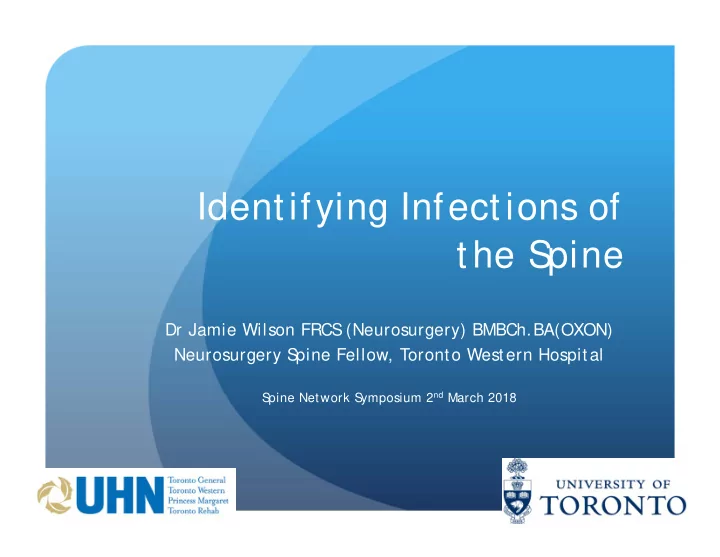

Identifying Infections of the S pine Dr Jamie Wilson FRCS (Neurosurgery) BMBCh.BA(OXON) Neurosurgery S pine Fellow, Toronto Western Hospital ymposium 2 nd March 2018 S pine Network S
The Honest Truth Low Yield: Y ou will investigate many patients who have no evidence of infection Relatively Rare: Y ou will miss/ diagnose late cases of spine infection
Case 1 Patient A Patient B 40 yo male 40 yo male Left leg S Left leg S 1 pain 1 pain 2-3d onset 2-3 d onset S Cough 10 days ago ome fever 7-10 d ago O/ E Depressed left ankle O/ E Depressed left ankle j erk j erk Parasthesia left S Parasthesia left S 1 1
But… .. Patient A Patient B 40 yo male 40 yo male Left leg S Left leg S 1 pain 1 pain IV Drug user No medical history S Blood work normal kin ulcer right foot WCC 17 CRP 35
Patient B Patient A Case 1
Outcomes Patient A: Blood cultures identified S taph Aureus IV antibiotics / Debridement of Leg Ulcer Did NOT require any surgical treatment Patient B: Temporary improvement with nerve root block L5/ S 1 Discectomy
Lessons from Case 1 Identifying risk factors is key Low threshold to investigate Most infections of the spine require a period of hospital treatment S urgery is not always required
S pine Infections Discitis / S pondylitis S pinal Abscess: Epidural (S ubdural) (Intramedullary) Post-operative (early vs delayed)
Pathogens Pyogenic / Bacterial Granuloma – Fungi Granuloma –TB No organism in 30%
Risk Factors Haematogenous S pread vs direct inoculation Previous S pinal S urgery S epsis from other source IVDU Immunocompromised / Diabetes / S teroids Age / High or Low BMI Exposure to TB
Work Up History – Pain, neurology, risk factors Exam – Complete Imaging – XR/ CT - MRI with contrast
Goals for Treatment Identify organism IV antibiotics (6 weeks or more, 1 year + for TB) Close observation of neurology and/ or deformity Follow up – clinical / imaging (XRs / MRI)
Indications for surgery Compressive collection with neurological deficits Bony destruction / deformity Failure of non-operative management
When to refer urgently? Back / Neck / Limb pain is common! New neurological or sphincter deficits Risk factors for infection (inc TB) Fever or abnormal blood work Prolonged sepsis from another source New deformity on XR History of S pine surgery – recent or not
Case 2 60yo male 10 days intermittent fever Cough at times Previous anterior cervical surgery for spinal cord inj ury 8 years ago
Case 2 Increasing respiratory difficulty Generalised weakness / unable to walk Admitted to hospital for LRTI / S epsis S tarted on IV antibiotics S eems appropriate?
Case 2 Family reported new right arm and leg weakness 3 days after admission continued fever WCC and CRP no response 1-2/ 5 paralysis of right side
Case 2
Case 2
Case 2
Outcome Intubated on ICU with initial neurological recovery Underwent further posterior C2-T2 fixation and decompression Recovered power on right side to 3-4/ 5, left 4/ 5 Tracheostomy Died 20 days post admission
Lessons from Case 2 Previous surgery is an important risk factor (even if not recent!) Any neurological deterioration requires urgent investigation S pinal infections can be rapidly progressive, and can cause irreversible neurological deficits/ death, if not appropriately identified
S ummary (S potting the Zebra) Identify Risk Factors early Low Index of S uspicion Investigate Thoroughly Treat for an adequate duration Follow Up Appropriately Refer to S pine S urgeon Early!
Thank Y ou Dr Jamie Wilson is kindly supported by the Dowager Countess Eleanor Peel Trust Travel Grant and the Ethicon Foundation Travel Award.
Recommend
More recommend